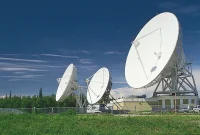A communication system is a complex network of interconnected components designed to transmit, receive, and exchange information between individuals, devices, or entities. It serves as the infrastructure that enables the sharing of data, messages, or signals over short or long distances, facilitating effective and timely communication. Communication systems are omnipresent in our modern world, encompassing a wide range of technologies and applications.
Key Components of a Communication System:
- Source: The source is the originator of the information to be communicated. It could be a person, a computer, a sensor, or any entity producing data or messages.
- Transmitter: The transmitter converts the information from the source into a form suitable for transmission over a communication channel. This process may involve encoding, modulation, or other techniques depending on the nature of the information and the communication medium.
- Communication Channel: The communication channel is the physical or logical pathway through which the information travels from the transmitter to the receiver. It can take various forms, including wired channels (such as cables or fiber optics) or wireless channels (such as radio waves or microwaves).
- Receiver: The receiver is responsible for capturing and decoding the transmitted information. It reverses the processes applied by the transmitter to retrieve the original data or message.
- Destination: The destination is the intended recipient or endpoint of the communication. It could be a person, a device, or a system that needs to receive and interpret the information.
- Noise: Noise refers to any unwanted interference or distortion that may occur during the transmission of information. It can be caused by various factors, such as electromagnetic interference, signal attenuation, or environmental conditions.
- Feedback: Feedback mechanisms allow for the monitoring and adjustment of the communication system based on the received information. Feedback helps ensure the reliability and quality of communication.
Types of Communication Systems
- Analog Communication Systems: Analog communication involves the transmission of continuous signals, such as analog audio signals or varying voltage levels. Examples include traditional telephony and analog radio broadcasts.
- Digital Communication Systems: Digital communication uses discrete signals represented by binary code (0s and 1s). Digital systems offer advantages in terms of noise resistance and the ability to transmit various types of data, including text, images, and video. The internet, mobile networks, and digital broadcasting are examples of digital communication systems.
- Wireless Communication Systems: Wireless communication systems transmit information without the need for physical cables. Examples include Wi-Fi networks, cellular networks, satellite communication, and Bluetooth technology.
- Optical Communication Systems: Optical communication involves the use of light signals to transmit information through optical fibers. Fiber-optic communication systems are widely used for high-speed data transmission over long distances.
- Satellite Communication Systems: Satellite communication utilizes orbiting satellites to relay signals between ground-based transmitters and receivers. This technology is essential for global communication, broadcasting, and navigation systems.
- Data Communication Systems: Data communication systems focus on the exchange of digital data between computers or devices. Local area networks (LANs), wide area networks (WANs), and the internet are examples of data communication systems.
- Mobile Communication Systems: Mobile communication systems enable wireless communication through mobile devices such as smartphones and tablets. These systems include cellular networks and technologies like 4G and 5G.
Communication systems play a pivotal role in connecting people, devices, and organizations, fostering the exchange of information that is vital for various aspects of daily life, business, science, and technology. As technology continues to advance, communication systems evolve to meet the growing demands for faster, more reliable, and more versatile means of communication.



